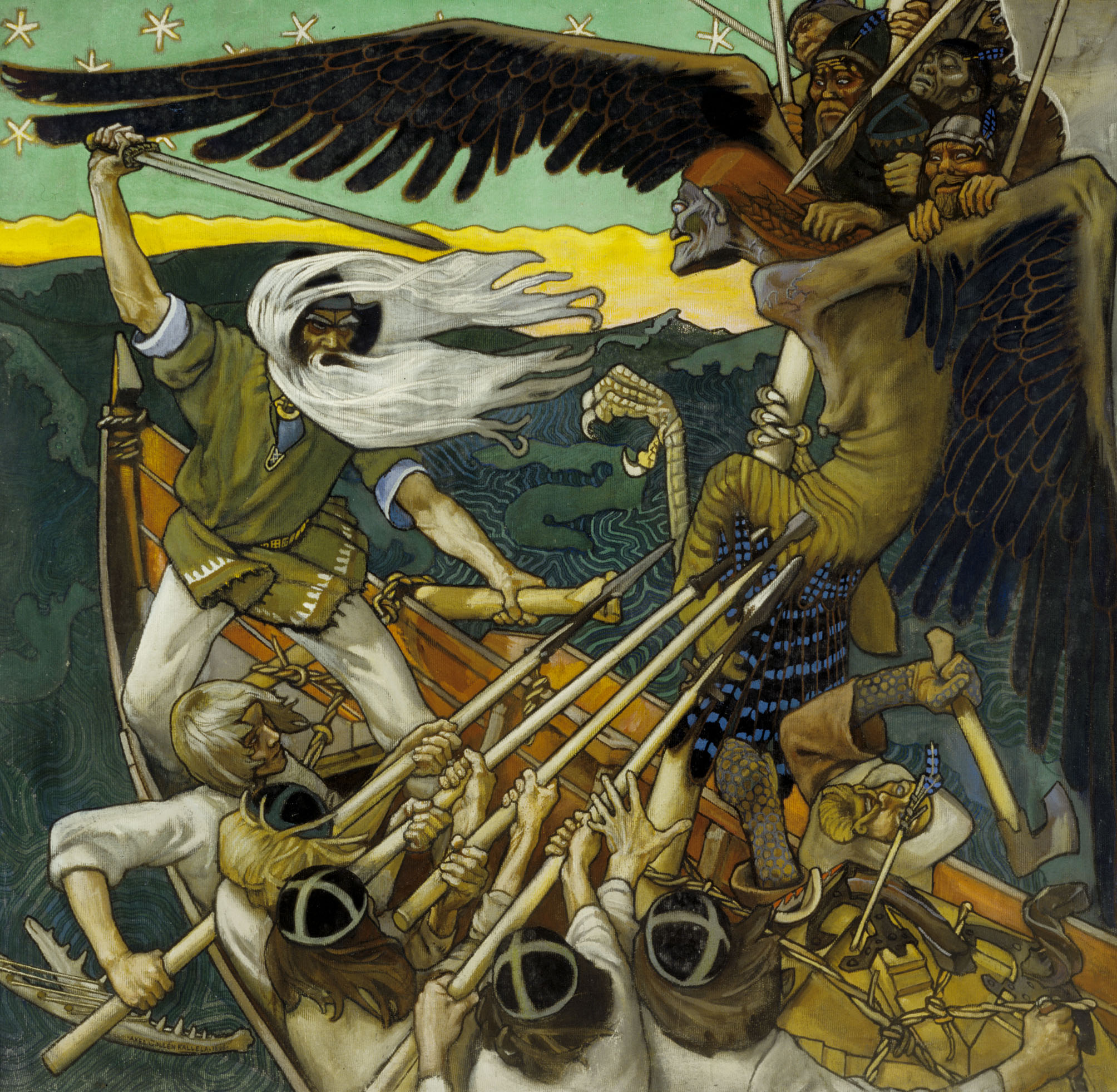
Do you know the stories of The Kalevala? If you do you are in select company like J.R.R. Tolkien who loved the stories and drew on them for his own writing. Unlike the tales of the Norse and the Celts, the tales of the Finns seldom take centre stage in discussions of myth and folklore. The traditional view of Finns as taciturn introverts probably doesn’t help raise the profile of these tales (typical joke: a Finnish extrovert looks at your shoes instead of her own). However, these stories deserve a wider audience and I know the #FolkloreThursday folks are just the crowd to give them love.
Like many small countries beginning to gain independence at the end of the 19th century, Finland wanted to recover its own folk tale traditions, once overshadowed by the culture of its Swedish and then Russian rulers. The poems or songs called runos were gathered by doctor-turned-folklorist Elias Lönnrot, who assembled the major poems into a kind of narrative. The tales tell the heroic history of Finland through the age of heroes, right up to the arrival of Christianity and the departure of magic. It all begins when Ilmatar the Goddess of the Air rests in the wild waters and a bird lays an egg on her knee. From its shards the sage Väinämöinen is born and he takes on the task of making trees and land for the watery world to give people a place to dwell.
“The poems or songs called runos were gathered by doctor-turned-folklorist
Elias Lönnrot, who assembled the major poems into a kind of narrative.”
Many of the tales tell the adventures of the sage Väinämöinen and how he uses his magic to accomplish great deeds like creating the kantele, the harp of the people. The traditional five string lap harp with its distinctive ringing sound is still popular in Finland, often used in schools, while the modern concert kantele with 32 strings graces performance halls. He’s probably most famous for persuading the smith Ilmarinen to forge the Sampo, the magic mill that grinds wheat out one side, salt out another and gold out of the third side.
The mill is a bribe for the witch Louhi who rescues Väinämoinen when he is cast adrift on the ocean. She picks him up in her form as a great eagle. The leader of Pohjola, the people of the north, her powers are great and her daughters avidly sought after. She has great magic: at one point she steals the sun and moon and locks them away. Louhi suggests that she will give her daughter’s hand in marriage if the sage accomplishes the task of securing the Sampo. When the smith Ilmarinen refuses to go to Pohjola, the heedless Väinämöinen forces him to comply —he too is eager to see the dream made real. In the north the reluctant Ilmarinen builds the Sampo, which creates endless wealth for the northern people. Well, we all know how these things go awry in folklore: soon the people of Kaleva and those of Pohjola are fighting over the Sampo. Eventually the magic mill is destroyed in the battle and the pieces sink to the bottom of the sea.
“She has great magic: at one point she steals the sun and moon and locks them away.”
It did not take long for me to see the stories were told from a particular point of view. Not only were the Kaleva folk in the south portrayed more sympathetically, but the stories were all about Väinämoinen’s perspective. Something seemed to be missing and I wanted to know more. I couldn’t help wondering what the stories would be like from Louhi’s point of view—or indeed any of the other women in the stories like Aino. Her brother loses a battle with Väinämöinen—who sings him into a swamp—and promises his sister as a bride to spare his life. Aino doesn’t want to be married to the ancient sage and drowns herself instead. Louhi has amazing shamanic powers but she’s only an ‘evil’ foil to the ‘real’ hero. But what if we heard the stories from her mouth?
Of course I started writing those stories. They ended up in my collection Dream Book (Fox Spirit Books). While I worked on the stories I played in a kantele group with my friends Kasha and Mina which we called Louhi’s Daughters. We brought the folklore and music of The Kalevala to new audiences. I met my cousins in Finland and discovered my family came from the north of Finland (though our family cabin in Michigan is in the town called Kaleva). I won a Finlandia Foundation grant to go to Finland and photograph ancient rock paintings. It was even more inspiring than I expected. The play that closes my collection popped into my head almost complete as we sailed across Lake Saimaa to where the ancient red ochre paintings are found.
Probably the most famous image of Louhi is Akseli Gallen-Kallela’s painting, The Defence of the Sampo. She’s portrayed in her eagle form, as much hag as bird. Though I love the power of his paintings, I long for images that show Louhi’s heroism, too. Such power! She has inspired music, too, like Kalevi Aho’s Louhi and (my fave) Tomi Räisänen’s Louhen loitsut/Louhi’s Spells. Listen to that piece and feel the power of the great witch of the north.
Look into The Kalevala and its sister text, The Kanteletar which includes the non-epic folks songs like the one that inspired my story Palakainen (which you can read for free at my site). I recommend the Friberg translation of The Kalevala but there are many others and The Kanteletar is available in an affordable World Classics edition translated by Keith Bosley. And if you fancy film check out Sampo (1959) and Jade Warrior (2007) if you can find them for interesting explorations of the mythology.
Thanks to the #FolkloreThursday team for inviting me!


